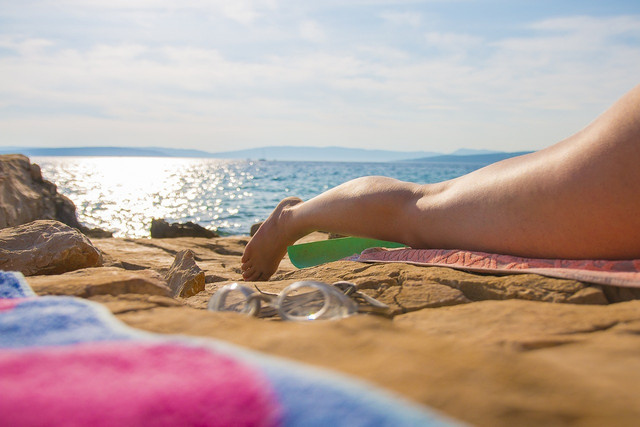What's the difference between mineral, physical and chemical sunscreen? Which is the one with zinc oxide again? Is sunscreen bad for you — or the environment? What does SPF measure and "broad spectrum” mean? You’ve got questions, we’ve got answers.
Somehow, when we weren’t looking, the topic of sunscreen has become mind-numbingly complex. We know that the last thing you want to do when you’re on your way out the door to the beach is do a deep dive into the literature on the subtle (and not so subtle) differences between types of sunscreen.
So we’ve done the work for you. In this article, we’ll tell you everything you need to know about the difference between chemical and physical (=mineral) sunscreen, and what to look for when buying sun protection.
Do I Really Have to Wear Sunscreen? The Importance of UVC, UVB and UVA rays

(Foto: CC0 / Unsplash / Stanley Dai)
Yes. Why? Because skin cancer sucks. Whether you choose chemical or physical sunscreen (mineral sunscreen), some form of protection is an absolute must. Here’s what you need to know about how different kinds of UV light from the sun can damage your skin.
UV radiation is measured by the UV index and is divided into three main categories:
- UVA: 320–400 nm
- UVB: 290–320 nm
- UVC: 260–290 nm
UVC rays are mostly filtered out by the atmosphere, so we don’t have to worry too much about those.
UVB rays burn the surface of your skin, causing things like sunburn and skin cancer. Recent studies suggest that 70 percent of new skin cancer cases diagnosed each year are the result of exposure to the sun.
UVA rays penetrate deep into your skin, causing long-term damage like wrinkles and aging. To protect yourself against all of the harmful rays of the sun, the first thing to look for when buying any sunscreen is to make sure that broad spectrum protection is stated specifically on the packaging. All fully mineral-based physical sunscreens provide broad spectrum protection by design.
Learn more: How Are UVA vs. UVB Rays Different?
What Does SPF Stand For?



(Foto: CC0 / Unsplash / Clay Banks)
Okay, so we agree that wearing sunscreen is important, whether it’s physical or chemical sunscreen. Now what about SPF? What does that even mean? SPF (sun protection factor) is a measure of a particular sunscreen’s ability to protect you from UVB rays (note: NOT UVA rays).
The numbering system might confuse you: Why does the highest number seem to be 50, not 100? Does the number stand for the minutes the sunscreen allows you to stay protected? Actually, it does have something to do with minutes, but it’s not quite that simple.
The SPF number are the fraction of UV rays that can get through to your skin. Two examples:
- With SPF 30 sunscreen, a thirtieth of UV rays get through, which is 3,3 percent.
- With SPF 50, a fiftieth, so 2 percent of UV light will hit your skin.
This means that how long you can stay in the sun for depends on how sensitive to sun damage your skin is in the first place. Multiply the time you can stay in the sun without getting red with no sunscreen on (“self-protection time”) with the SPF, and that’s how long you should ideally stay protected. In short:
self-protection time x SPF = minutes you are theoretically protected in the sun
Light-skinned people usually have a self-protection time of about 10 minutes. For darker skin types, perhaps surprisingly, it is not that much longer. Even type 6 on the Fitzpatrick scale on skin tones, the darkest skin type, only has a self-protection time of 90 minutes according to most sources. It is therefore a myth that dark-skinned people cannot get sunburned. Here’s an example calculation for a medium-dark skin type (type 3) using a SPF 30 sunscreen:
15 x 30 = 450 minutes in the sun, which are 7,5 hours
This should also explain why you rarely find sunscreen with an SPF of 100: the protection ends up being only one percent higher than with SPF 50. Experts agree that the extra one percent isn’t worth it — it might even encourage buyers to stay out in the sun even longer because they might feel they are “100 percent” protected. Instead, the experts emphasize the importance of reapplying sunscreen liberally through the day and limiting your time in the sun. Nevertheless, most dermatologists recommend using sunscreen with a rating of at least SPF 30.
Be aware that these numbers are valid for the ideal scenario. So as soon as you don’t reapply the sunscreen exactly as advised, for example when sweating, the protection goes down by quite a bit. So don’t extend your stay in the sun from 15 minutes to almost 8 hours just because you have sunscreen on.
Physical / Mineral vs Chemical Sunscreen: What’s the Difference?



(Foto: CC0 / Pexels / RF._.studio)
Chemical sunscreen is the conventional sunscreen that you’ve always known and loved. It protects you from the UV rays of the sun by first absorbing into your skin, and then absorbing and transforming UV rays into heat, which is then released into the air. This is done using active ingredients like avobenzone, octinoxate, or oxybenzone, which are all organic (carbon-based) compounds.
Physical sunscreen, sometimes called mineral sunscreen, contains tiny mineral particles which sit on top of your skin and act as filters, physically reflecting and deflecting the sun’s rays. The main active ingredients used in mineral sunscreen are zinc oxide and titanium dioxide. Zinc oxide sunscreen is often recommended as the safest and most environmentally friendly (more on that later).
Note: Although most sunscreen will fall into one of these two categories, combination products also exist. Always read the label carefully!
The Case Against Chemical Sunscreen: Two Problems



(Foto: CC0 / Pixabay / MBatty)
Many people choose chemical over physical sunscreen because it is easier to apply, it tends to be more waterproof, it can easily be combined with moisturizers, and less product is needed to get protection. But there are two really, really big problems with chemical sunscreen:
1: The Health Problem
The thing is, unlike mineral sunscreen, chemical sunscreen gets absorbed into your skin. That means the active ingredients that are in the sunscreen could also get into your body. And it turns out, they do.
According to the EWG, studies show that compounds such as oxybenzone, octinoxate, octisalate, octocrylene, homosalate, and avobenzone are all systemically absorbed into the body after a single use, and can be detected on the skin and in blood weeks after application. In fact, the CDC estimated that about 97% of Americans have oxybenzone in their blood. Some of these chemicals have even been found in mother’s milk. Unhelpfully, the FDA states that it has insufficient data to determine whether or not these chemicals pose any safety risks. We find that more than a little bit disconcerting.
To make it worse, many of these chemicals have been shown to disrupt hormones like estrogen, androgen, and progesterone, and have even produced thyroid and behavioral alterations in animal studies. If that’s not enough fun for you, ingredients like oxybenzone and octocrylene are reported to generate allergic reactions in the skin at a high rate.
You can find the full chart of active ingredient toxicity here.
Chemical sunscreen especially shouldn’t be used once expired. Learn more: Can You Use Expired Sunscreen? Here’s What to Check to be Sure



(Foto: CC0 / Unsplash / QUI NGUYEN)
2: The Coral Reef Problem
While there might not be enough data to show whether or not chemical sunscreen is toxic for your body, there is more than enough evidence to prove that it is helping to destroy the world’s coral reefs.
According to National Geographic, 14,000 tons of sunscreen are thought to wash into the oceans each year. Three active ingredients found in sunscreen made in the USA, oxybenzone, octinoxate, and butylparaben, have been shown to be incredibly damaging to coral reefs in numerous ways. These chemicals disrupt coral reproduction, cause coral bleaching, and damage coral DNA.
The Case for Physical / Mineral Sunscreen: Its Pros
Physical sunscreen offers several benefits for you and the Earth:
- Because physical sunscreen, or mineral sunscreen, works by sitting on top of your skin and doesn’t contain active chemical ingredients, you don’t run the risk of introducing possibly toxic chemicals into your body when you use it.
- Mineral sunscreen is also much less likely to cause allergic reactions.
- It is broad-spectrum by nature
- It won’t clog your pores.
- If you choose the right physical sunscreen, it can be completely safe for the environment (more on this below).
Physical / Mineral Sunscreen: The Nanoparticle Problem
The biggest complaint that people have about physical sunscreen is that it is more difficult to apply than chemical sunscreen, and is more visible on the skin since it does not become absorbed the way chemical sunscreen does. In order to combat this, many companies have tried to make the mineral particles in their sunscreens as small as possible. But particles that are very, very small, or nanoparticles, reintroduce environmental risks, because they can be ingested by coral reefs and other marine animals, causing internal damage.
There has also been some concern as to whether nanoparticles could be absorbed into the human bloodstream. Although several studies have shown that nanoparticles in physical sunscreen do not penetrate the skin, the utter lack of FDA regulation surrounding nanoparticles still makes many people uncomfortable.
How to Use Mineral Sunscreen for 100 % Effectiveness
If you’re not used to using mineral sunscreen, there are a few things to pay attention to:
- Mineral sunscreen must be applied generously, to make sure that there are no gaps between mineral particles.
- Physical sunscreen contains either zinc oxide, titanium dioxide, or both. Zinc oxide sunscreen is generally considered better, because titanium dioxide has been shown to be more irritating to the skin, and is significantly less effective at protecting you from UVA rays.
- Physical sunscreen washes off easily, and must be reapplied if you are swimming, or sweating.
- Avoid powdered mineral sunscreen: inhaling mineral particles is associated with lung cancer.
Physical or Chemical Sunscreen: The Bottom Line



(Foto: CC0 / Unsplash / Matheus Vinicius)
We recommend physical sunscreen that has been certified by the Haereticus Environmental Laboratory as reef-safe and free of nanoparticles.
Because manufacturers do not currently have an obligation to list particle size on sunscreens, and since the words “natural” and “organic” are not regulated by the FDA, plus the general permissibility of arcane labeling practices in the United States, it is incredibly difficult for consumers to make an informed decision when trying to purchase sunscreen. The help of a third party is essential.
The Haereticus Environmental Laboratory, a non-profit scientific organization, has developed a “Protect Land + Sea” Certification Seal. Physical (mineral) sunscreen that has been labeled with this seal has been laboratory‐tested using analytical‐forensic techniques to verify that the product is free of the chemicals that are on the “HEL LIST”, which are:
- Any form of microplastic sphere or beads
- Any nanoparticles like zinc oxide or titanium dioxide
- Oxybenzone
- Octinoxate
- 4-methylbenzylidene camphor
- Octocrylene
- Para-aminobenzoic acid (PABA)
- Methyl Paraben
- Ethyl Paraben
- Propyl Paraben
- Butyl Paraben
- Benzyl Paraben
- Triclosan
- Homosalate
- Octisalate
- Butyloctyl salicylic acid
- Propylparaben
- Any of the nylon powders used in cosmetics and personal care products, e.g., polyamide 6, nylon glitters
Also interesting: What Is Glitter Made of and Is Bio-Glitter Better?
The 5 Best Physical / Mineral Sunscreens of 2023



(Foto: CC0 / Unsplash / Alvin Balemesa)
And so, without further ado, the five physical sunscreens that have managed to achieve the “Protect Land + Sea” certification are:
1. Badger: Clear Sport Sunscreen Cream in a Tin — SPF 40
2. Olen: Sunblocz Baby and Kids Sunscreen — SPF 50
3. Stream2Sea Sport Sunscreen — SPF 30
- View certification results
- Website
- Buy product on Amazon**
4. Tropic: Various Products — SPR 15 to 50
5. Ocacité Sun Guardian Day Creme — SPF 30
Read more:
- 13 Problematic Ingredients in Cosmetics
- Synthetic Fluorphlogopite: Why We Need Synthetic Mica
- Summer Bucket List Ideas: 12 Activities You Can’t Miss
Do you like this post?








